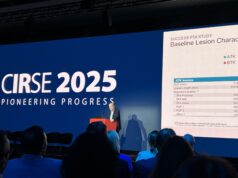
Data from two head-to-head trials on drug-eluting technologies in femoral artery treatment were presented during a late-breaking session at LINC 2021 (Leipzig Interventional Course; 25–29 January, virtual)—one-year TRANSCEND and two-year COMPARE results. Both studies point to the non-inferiority of lower-dose paclitaxel devices, prompting discussion on whether these results will see a trend towards using lower-dose devices in practice. Although these results are promising, the panel agreed that more data are needed.
Kenneth Rosenfield (Massachusetts General Hospital, Boston, USA) presented one-year results of the TRANSCEND study, a non-inferiority randomised trial comparing the efficacy and safety of the SurVeil drug-coated balloon (DCB; Surmodics) versus the IN.PACT Admiral DCB (Medtronic), and Sabine Steiner (University of Leipzig, Leipzig, Germany) presented two-year results from the COMPARE trial, assessing the Ranger DCB (Boston Scientific) compared to the IN.PACT device.
All DCBs assessed utilise the anti-proliferative drug paclitaxel. The SurVeil and Ranger DCBs both have a low dose of paclitaxel (2µg/mm²) compared the the IN.PACT Admiral DCB, which has a higher dose of 3.5μg/mm².
TRANSCEND one-year results: SurVeil demonstrates non-inferior efficacy and safety versus IN.PACT Admiral
Rosenfield announced that primary results of TRANSCEND demonstrate the non-inferiority of the SurVeil DCB compared to the IN.PACT Admiral DCB with regards to both safety and efficacy, while delivering a substantially lower drug dose.
In the TRANSCEND trial, the SurVeil DCB was found to be non-inferior to the IN.PACT Admiral DCB in both the primary safety and primary efficacy endpoints. The SurVeil DCB cohort (n=222) exhibited a strong safety profile with 91.7% of subjects demonstrating freedom from device- or procedure-related death within 30 days and freedom from above-ankle amputation or clinically-driven target vessel revascularisation (CD-TVR) within 12 months, compared to 89.6% of subjects treated with the IN.PACT Admiral DCB (n=224).
The SurVeil DCB group also met its efficacy endpoint of primary patency of 81.7% as compared to 85.9% of the IN.PACT Admiral DCB arm. In addition, the number of reinterventions deemed clinically necessary by physicians did not differ between the products.
COMPARE two-year results: Ranger continues to demonstrate similar patency rate to IN.PACT
Two-year results from COMPARE, the first head-to-head comparison of two DCBs with different paclitaxel dosages and coating technologies for femoropopliteal interventions, were also presented.
The study compared the lower paclitaxel dose Ranger DCB to the higher paclitaxel dose IN.PACT Admiral DCB. One-year results of COMPARE were presented for the first time during LINC 2020 (Leipzig Interventional Course; 28–31 January, Leipzig, Germany) and published concomitantly in the European Heart Journal.
At two years, the Ranger DCB, which has a significantly lower drug dose density of paclitaxel continued to demonstrate a similar primary patency rate to the higher-dose IN.PACT DCB with a freedom from restenosis rate of 70.6% for the Ranger DCB (n=207) compared to the 71.4% observed with the IN.PACT DCB (n=207), according to Kaplan-Meier estimate (log-rank p=0.96).
No significant differences were observed for other secondary two-year outcomes, Steiner informed the LINC audience, detailing low all-cause mortality rates at two-years with 3.6% for the Ranger DCB vs. 2.2% for the IN.PACT DCB (p=0.6).
In addition, there was a low clinically-driven target lesion revascularisation (CD-TLR) rate through two years—17.8% for the Ranger DCB vs. 13% for the IN.PACT DCB (p=0.3).
Results for low-dose devices “reassuring,” but more data needed
Subsequent discussion focused on the significance of these results, with moderator Dierk Scheinert (University of Leipzig, Leipzig, Germany) posing the question: “Are low-dose balloons the way to go in the future?”
Rosenfield responded: “I think that this new generation of balloons is going to be better, and the safety data are comparable. If you are going to use multiple balloons in a given patient, I would certainly feel a lot more comfortable using a lower-dose balloon with better transmission of the drug and with less particulates downstream. I believe that this is going to be the way to go. Also, the technology is constantly improving.”
Steiner was in agreement, noting that the results are “reassuring”. While the data from both TRANSCEND and COMPARE point in a similar direction, Scheinert was curious to know if there are any key differences between the datasets. “COMPARE included longer lesions, up to 30cm,” Steiner began, adding that it also included more chronic total occlusions (≈40% CTOs). However, the speaker noted this design came at a price, referring to a much higher bailout stenting rate than TRANSCEND. Steiner also remarked that with the “more typical” design of TRANSCEND, with lesions of up to 18cm only, non-inferiority for a low-dose versus a high-dose balloon was also evident.
Both TRANSCEND and COMPARE assessed low-dose devices to the high-dose IN.PACT Admiral DCB. In the same late-breaking session, Thomas Zeller (Universitäts-Herzzentrum, Bad Krozingen, Germany) had presented long-term data on this device. Scheinert asked for his opinion on the results.
“We have to wait for longer-term follow-up data in order to see whether there will be a difference in terms of future safety endpoints,” Zeller remarked. “However, it is interesting to see that all the data with the first-generation DCB [IN.PACT Admiral] are more or less in line, independently of whether the maker of this device has conducted the trial, or if this balloon was used as a control,” he added, highlighting the strong data available for the device.
In terms of whether this should herald a move towards low-dose devices, Zeller was unconvinced: “I do not see a reason to switch, and I do not know whether it is really necessary.”
Panellist Marianne Brodmann (University of Graz, Graz, Austria) also commented, echoing Rosenfield: “If a low-dose device is as safe and as efficient in the long term as a high-dose device, I think a lot of physicians might feel more comfortable to use a low-dose device.” However, she also stressed that more data on these low-dose devices are needed.











